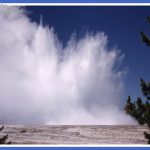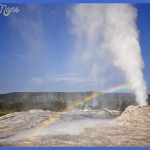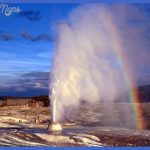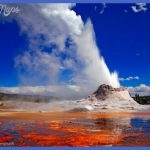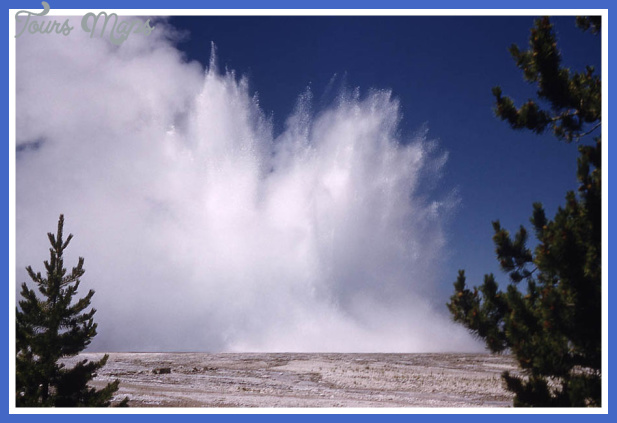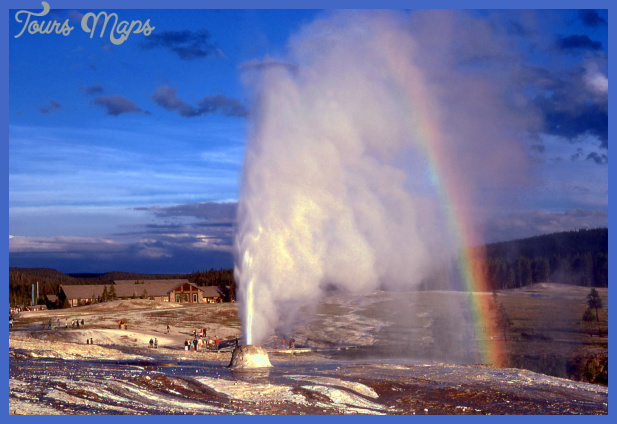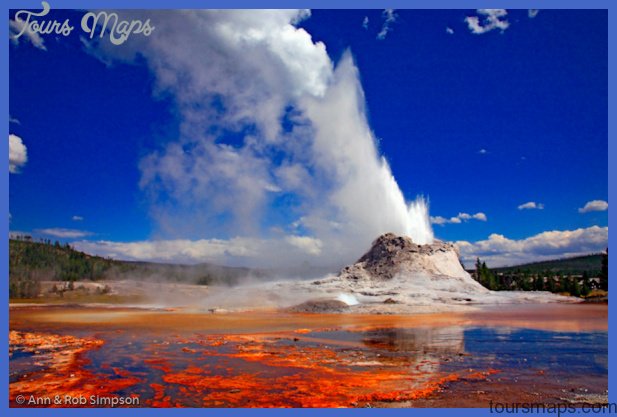The number of hot springs in the park has been estimated to be around 10,000; geysers active at any one time number at least 500. No one knows the exact numbers. However, the Y.N.P. Spatial Analysis Center is now assembling a baseline inventory of geothermal features. Since 2006 the Thermal Biology Institute of Montana State University at Bozeman has been using this inventory to provide an online data set and to coordinate the efforts of thermal researchers. Browse the geothermal features database at: www.rcn. montana.edu/resources/. Some people are not enthralled by geyser basins. You might agree with Owen Wister, author of The Virginian, who visited in 1887: I do not like them or their neighborhood. The air has drafts of stenches through it sometimes like sulphur, sometimes like a stale marsh.
The ground is drilled with hissing puddles and sounds hollow as you walk, and all healthy plants and grass keep at a prudent distance. . . . Others of us are more like survey leader Hayden, who, according to Harry J. Norton’s 1873 guidebook, cannot compose himself in presence of a geyser in eruption; but, losing recollection of the material world for the time, rubs his hands, shouts, and dances around the object of his admiration in a paroxysm of gleeful excitement. To learn more about geysers, you might consult the geyser books listed in the Yellowstone Books and Maps chapter or contact the Geyser Observation and Study Association (see Travel Tips for contact information). The main source for this guide’s material about geysers is The Geysers ofYellowstone (2008), by geologist and former ranger T. Scott Bryan. (1.25) White Dome Geyser has a 20-foot-high cone atop a 12-foot-high mound (6 m atop 3.6 m), both built up from the deposit of sinter or geyserite.
To build such a mound, a hot spring or splashing geyser must have deposited sinter here steadily for centuries before the present feature built the cone. White Dome is a cone-type geyser; that is, a geyser whose eruption emits a steady column of water from a narrow vent within a cone. Much of the actual cone is not white, but is stained pink from a manganese compound. White Dome’s unpredictable (but in most years, frequent) eruptions go as high as 30 feet (9 m). (1.3) The jumble of interlaced channels of hot water coming from the right is aptly named Tangled Creek. (1.65) Pink Cone is very close to the road. Its eruptions, about once daily, last up to 2 hours, as high as 30 feet (9 m). It was never known to erupt until 1937. In this area are a few other small geysers and Old Bath Lake, also called The Tank in earlier years. Researchers believe prehistoric peoples used and perhaps altered it.
Tree sections dam up the spring, creating surprisingly regular sides. Thermal areas to the right and left of the road are closed to all visitation. (2.1) I Parking area for Firehole Lake and its associated hot springs (sometimes called Black Warrior Springs). Take the boardwalk to the left of the road and the left branch of the board- walk to see Steady Geyser, also called Black Warrior Geyser. Steady has almost never quit spouting in over 100 years. This perpetual spouter (technically not a geyser) may even be the world’s largest, since it sometimes goes 15 feet (4.6 m) high. Notice the small oval or scallop formations built up from the mineralladen water. These are geyser eggs made of travertine. Crossing by footbridge over the steaming runoff channels, you see thousands of colonies of orange cyanobacteria Pink Cone is tinted by manganese compound deposits. and algae.
The Hot Cascades here drain steaming water into Hot Lake, which is primarily a collecting basin rather than a lake, but may have hot springs within it. The outlet (western end) of Hot Lake is cool enough for Canada geese to swim on it. They sometimes nest on grassy hummocks next to the lake. The lake created by Steady Geyser’s runoff is Black Warrior Lake, named for its unusual dark olive green or almost black lining. Cross the road to take the other boardwalk along Firehole Lake and its several spouting springs. Unlike the Fire-hole River, Firehole Lake and Spring got their names from the blue flame-like appearance of the large steam bubbles you can often see rising from within them. Continuing on the Grand Loop Road 9.5/7.5 @(17) S© Just south of a quiet meadow (unocially called Whiskey Flats) is Whiskey Flats picnic area. Yellowstone Park sign maker Virgil Hall gave up making WHISKEY FLATS Three small geysers on the edge of Firehole Lake may be erupting when you’re here.
Nearest the road are the many vents of Young Hopeful Geyser, erupting almost perpetually from two craters, which formed when it underwent a steam explosion in the 1970s. Close to Young Hopeful is Gray Bulger Geyser. Its numerous small vents constantly spray water or emit steam, making an entertaining racket. Farthest from the road is Artesia Geyser, whose eruptions are usually under 5 feet (1.5 m) high. (3.3) Junction with Grand Loop Road. Opposite is the parking area for the Fountain Paint Pot area. Turn left for Old Faithful, right for Madison Junction. signs, when 18 of them were stolen in less than two years’ time! 9.9/7.1 S©(2) Midway Geyser Basin.
About Yellowstone’s Geysers Photo Gallery
Maybe You Like Them Too
- The Best Cities To Visit in The World
- World’s 10 Best Places To Visit
- Coolest Countries in the World to Visit
- Travel to Santorini, Greece
- Map of Barbados – Holiday in Barbados

